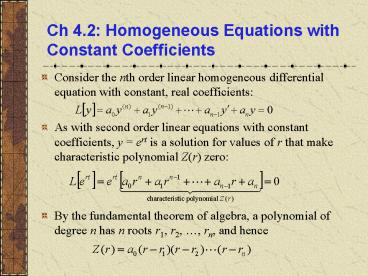Ch 4'2: Homogeneous Equations with Constant Coefficients - PowerPoint PPT Presentation
1 / 12
Title:
Ch 4'2: Homogeneous Equations with Constant Coefficients
Description:
As with second order linear equations with constant coefficients, y = ert is a ... By the fundamental theorem of algebra, a polynomial of degree n has n roots r1, ... – PowerPoint PPT presentation
Number of Views:304
Avg rating:3.0/5.0
Title: Ch 4'2: Homogeneous Equations with Constant Coefficients
1
Ch 4.2 Homogeneous Equations with Constant
Coefficients
- Consider the nth order linear homogeneous
differential equation with constant, real
coefficients - As with second order linear equations with
constant coefficients, y ert is a solution for
values of r that make characteristic polynomial
Z(r) zero - By the fundamental theorem of algebra, a
polynomial of degree n has n roots r1, r2, , rn,
and hence
2
Real and Unequal Roots
- If roots of characteristic polynomial Z(r) are
real and unequal, then there are n distinct
solutions of the differential equation - If these functions are linearly independent, then
general solution of differential equation is - The Wronskian can be used to determine linear
independence of solutions.
3
Example 0
- Consider the initial value problem
- Assuming exponential soln leads to characteristic
equation - Factoring yields two solutions, r1 -4 and r2
3 - The general solution has the form
- Using the initial conditions
- Thus
4
Example 1 Distinct Real Roots (1 of 3)
- Consider the initial value problem
- Assuming exponential soln leads to characteristic
equation - Thus the general solution is
5
Example 1 Solution (2 of 3)
- The initial conditions
- yield
- Solving,
- Hence
6
Example 1 Graph of Solution (3 of 3)
- The graph of the solution is given below. Note
the effect of the largest root of characteristic
equation.
7
Complex Roots
- If the characteristic polynomial Z(r) has complex
roots, then they must occur in conjugate pairs, ?
? i?. - Note that not all the roots need be complex.
- Solutions corresponding to complex roots have the
form - As in Chapter 3.4, we use the real-valued
solutions
8
Example 2 Complex Roots
- Consider the equation
- Then
- Now
- Thus the general solution is
9
Example 3 Complex Roots (1 of 2)
- Consider the initial value problem
- Then
- The roots are 1, -1, i, -i. Thus the general
solution is - Using the initial conditions, we obtain
- The graph of solution is given on right.
10
Example 3 Small Change in an Initial Condition
(2 of 2)
- Note that if one initial condition is slightly
modified, then the solution can change
significantly. For example, replace - with
- then
- The graph of this soln and original soln are
given below.
11
Repeated Roots
- Suppose a root rk of characteristic polynomial
Z(r) is a repeated root with multiplicty s. Then
linearly independent solutions corresponding to
this repeated root have the form - If a complex root ? i? is repeated s times,
then so is its conjugate ? - i?. There are 2s
corresponding linearly independent solns, derived
from real and imaginary parts of - or
12
Example 4 Repeated Roots
- Consider the equation
- Then
- The roots are 2i, 2i, -2i, -2i. Thus the general
solution is































